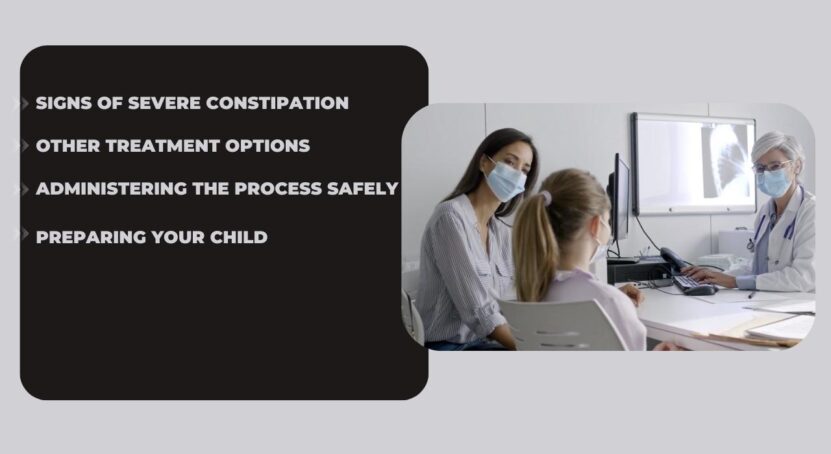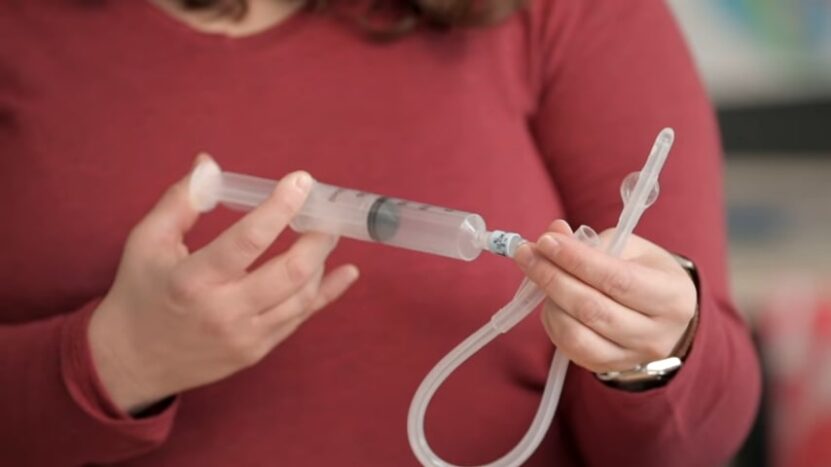Since I’ve become a parent, I’ve been facing challenges that I never even knew existed before having kids. One such challenge that took me by surprise was dealing with constipation in my little one.
It’s a topic we often shy away from, but it’s so common. When I first heard about using enemas for kids, I was both curious and cautious. I’ve spent time researching and consulting with experts to understand it better, and I wanted to share this knowledge with all of you.
Whether you’re considering it or just want to be informed, here’s what you need to know about this topic.
How Does The Treatment Work?
An enema works by introducing a specific amount of liquid, usually water or a saline solution, into the colon via the rectum. This liquid softens the stool, making it easier to pass.
Additionally, the introduction of the fluid can stimulate the muscles of the colon, prompting a bowel movement.
Types of Enemas
There are various types of enemas, each with its own purpose and composition. The most common types for children include saline, mineral oil, and bisacodyl. Saline enemas are often preferred for kids as they are gentle and effective.
Mineral oil enemas lubricate the stool, while bisacodyl enemas act as a stimulant to induce bowel movements.
When to Consider It?

It’s essential to know when an enema might be appropriate for your child. Not every case of constipation requires this intervention, and there are other methods to consider first.
Signs of Severe Constipation
While occasional constipation is common in children, there are signs that it might be more severe. These include not having a bowel movement for several days, abdominal pain, bloating, and hard, dry stools.
If your child exhibits these symptoms, it’s essential to consult with a pediatrician.
Other Treatment Options
Before resorting to an enema, there are other treatments to consider. Dietary changes, such as increasing fiber and fluid intake, can help. Over-the-counter stool softeners or laxatives might also be recommended by a doctor.
Physical activity can also stimulate bowel movements.
Administering The Process Safely
If you’ve decided that an enema is the right choice for your child, it’s crucial to administer it safely and comfortably. Remember, the goal is to alleviate discomfort, not add to it.
Preparing Your Child
Preparation is key. Explain the process to your child in simple terms, ensuring they understand the purpose and what to expect. Make sure the environment is calm and the child is as relaxed as possible.
Gather all necessary supplies beforehand, including the enema solution, gloves, and a towel.
Apply The Right Technique
Position your child on their side, with their knees drawn up to their chest. After lubricating the enema nozzle and the child’s anus, gently insert the nozzle no more than 1 to 1.5 inches. Slowly squeeze the solution into the rectum.
Ask your child to hold the solution for as long as they can, ideally 5-10 minutes, before using the toilet.
Potential Risks and Precautions

While this treatment can be beneficial, it’s essential to be aware of potential risks and take necessary precautions to ensure your child’s safety.
Possible Side Effects
Like any medical intervention, enemas come with potential side effects. These can include abdominal cramping, bloating, and an upset stomach.
In rare cases, there might be an allergic reaction to the solution used, or the rectal tissue could get irritated or injured.
Frequency of Use
It’s crucial not to over-rely on this treatment. Frequent use can lead to a dependency where the colon becomes reliant on enemas to function correctly. This can further complicate constipation issues.
Always consult with a pediatrician about the frequency of use.
Benefits of Enemas
While there are risks associated with this treatment, there are also undeniable benefits, especially when used appropriately and under a doctor’s guidance.
Immediate Relief
One of the primary benefits is the immediate relief it can provide. For children suffering from severe constipation, this can be a significant relief, both physically and emotionally.
Colon Cleansing
Enemas can also help cleanse the colon, removing accumulated waste and toxins. This can be particularly beneficial if the child has ingested something harmful, though in such cases, it’s vital to seek medical advice immediately.
Are There Any Alternatives to This Process?
While enemas can be effective, they might not be the best solution for every child. It’s worth exploring alternatives, especially for less severe cases of constipation.
Dietary Changes
Often, constipation can be alleviated with simple dietary changes. Increasing the intake of fiber-rich foods like fruits, vegetables, and whole grains can help. Ensuring your child drinks plenty of water is also crucial.
Natural Laxatives
There are natural laxatives that can be considered before resorting to enemas or over-the-counter medications. Foods like prunes, figs, and flaxseeds can act as natural stool softeners. It’s always a good idea to discuss these options with a pediatrician.
Psychological Impact of Constipation

Dealing with constipation can be more than just a physical challenge. The psychological effects, especially in children, can be profound and should not be overlooked.
Anxiety and Embarrassment
Children, especially as they grow older and become more socially aware, might feel embarrassed about their constipation issues. This can lead to anxiety, especially concerning school or social events where they might fear an accident.
Building Trust and Communication
Open communication is vital. Encourage your child to express their feelings and fears. Reassure them that they’re not alone and that it’s okay to seek help. Building this trust can alleviate some of the psychological stress associated with constipation.
The Role of Probiotics
Probiotics have gained attention in recent years for their potential benefits in gut health. They might be a consideration for children dealing with constipation.
How Probiotics Help
Probiotics are live bacteria and yeasts beneficial for the digestive system. They can help balance the gut’s good and bad bacteria, potentially aiding in regular bowel movements and overall gut health.
Choosing the Right Probiotic
Not all probiotics are created equal. If considering this route, it’s essential to choose a probiotic specifically designed for children. Consulting with a pediatrician can provide guidance on the best options and dosages.
Importance of Routine
Establishing a routine can play a pivotal role in managing and preventing constipation in children.
Regular Toilet Times
Encouraging your child to use the bathroom at specific times each day can help train their body to have regular bowel movements. Post-meal times are often effective since eating can stimulate the colon.
Physical Activity
Regular physical activity can help stimulate the intestines and promote regular bowel movements. Encourage your child to engage in physical play, sports, or even simple activities like walking or cycling.
FAQs:
Are There Any Age Restrictions for Using Enemas in Children?
Yes, age can be a factor. Infants and very young children have more delicate systems, and enemas might not always be recommended. Always consult with a pediatrician before administering the treatment to a child, especially if they’re under the age of 2.
Can I Use an Adult Kit for My Child?
It’s essential to use a pediatric enema kit for children. These kits are designed with a child’s size and needs in mind. Using an adult kit can introduce too much liquid or be too harsh for a child’s system.
Are There Any Natural Solutions I Can Use for The Treatment?
While saline solutions are commonly used, some parents opt for natural solutions like chamomile tea or aloe vera juice. However, it’s crucial to consult with a healthcare professional before using any alternative solutions to ensure safety and effectiveness.
How Will My Child Feel After It?
Most children feel relief after passing a bowel movement post-enema. However, some might experience temporary side effects like abdominal cramping or bloating. It’s essential to monitor your child and ensure they’re comfortable and hydrated after the procedure.
How Often Can I Administer the Treatment to My Child?
Enemas should not be a regular solution for constipation. Overuse can lead to dependency and other complications. If your child is frequently constipated, it’s essential to consult with a pediatrician to explore other treatment options and underlying causes.
The Bottom Line
Parenting is a journey filled with unexpected twists and turns. We all want what’s best for our children, and making informed decisions is a crucial part of that. I hope this guide on enemas for kids has shed some light on a topic that can often feel daunting.
Remember, every child is unique, and what works for one might not work for another. Always consult with a healthcare professional and trust your instincts. After all, we’re all in this together, learning and growing alongside our precious little ones.

